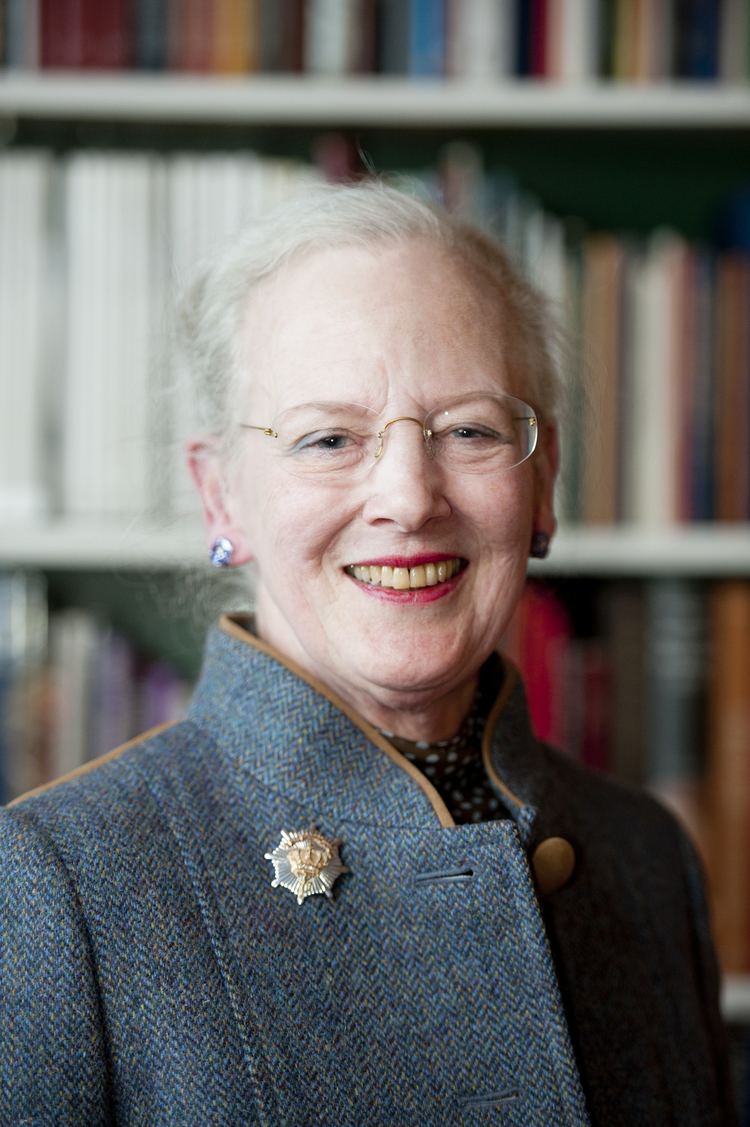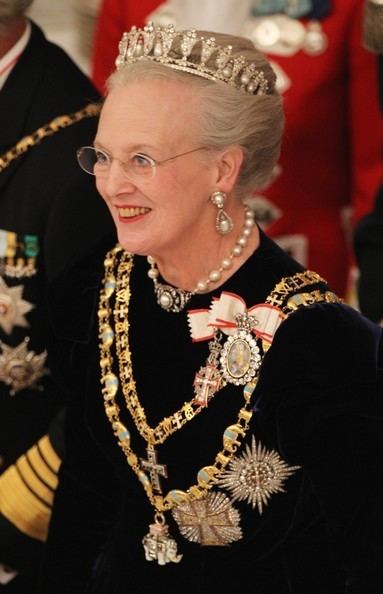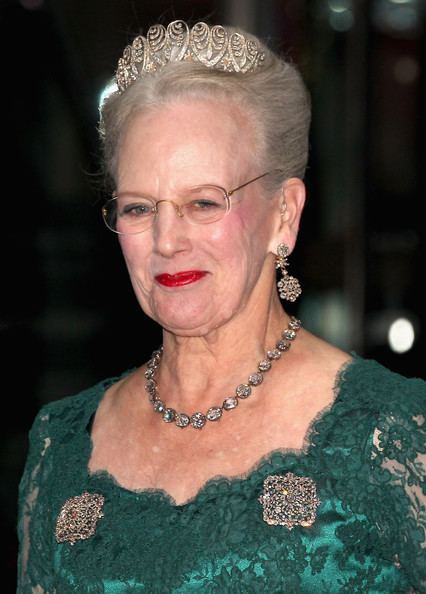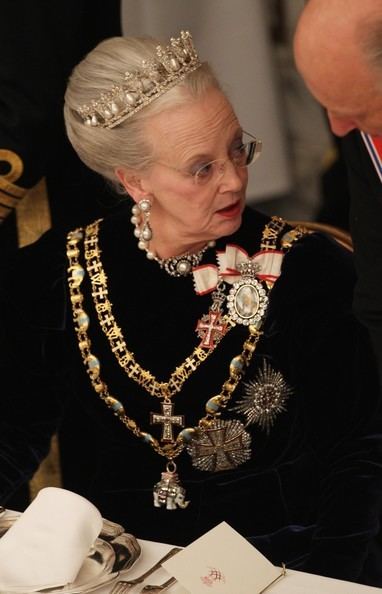Predecessor Frederick IX Name Margrethe of | House Glucksburg Height 1.8 m | |
 | ||
Reign 14 January 1972 – present Prime Ministers DenmarkJens Otto KragAnker JorgensenPoul HartlingPoul SchluterPoul Nyrup RasmussenAnders Fogh RasmussenLars Lokke RasmussenHelle Thorning-SchmidtLars Lokke RasmussenFaroe IslandsAtli DamJogvan SundsteinMarita PetersenEdmund JoensenAnfinn KallsbergJoannes EidesgaardKaj Leo JohannesenGreenlandJonathan MotzfeldtLars Emil JohansenHans EnoksenKuupik KleistAleqa HammondKim Kielsen Spouse Henrik, Prince Consort of Denmark (m. 1967) Children Frederik, Crown Prince of Denmark, Prince Joachim of Denmark Siblings Queen Anne-Marie of Greece, Princess Benedikte of Denmark Parents Frederick IX of Denmark, Ingrid of Sweden Similar People Henrik - Prince Consort o, Frederik - Crown Prince of, Mary - Crown Princess, Prince Joachim of Denmark, Princess Marie of Denmark | ||
Interview with Her Majesty Queen Margrethe II of Denmark
Margrethe II (Danish: Margrethe 2., [mɑˈɡʁæːˀdə]; Faroese: Margreta 2.; Greenlandic: Margrethe II; full name: Margrethe Alexandrine Þórhildur Ingrid; born 16 April 1940) is the Queen of Denmark. She is also the supreme authority of the Church of Denmark and Commander-in-Chief of the Danish Defence. Born into the House of Glücksburg, a royal house with origins in Northern Germany, she was the eldest child of Frederick IX of Denmark and Ingrid of Sweden. She succeeded her father upon his death on 14 January 1972, having had become heir presumptive to her father in 1953, when a constitutional amendment allowed women to inherit the throne. On her accession, Margrethe became the first female monarch of Denmark since Margaret I, ruler of the Scandinavian kingdoms in 1375–1412 during the Kalmar Union. In 1967, she married Henri de Laborde de Monpezat, with whom she has two sons: Crown Prince Frederik (born 1968) and Prince Joachim (born 1969). She has been on the Danish throne for 45 years, becoming the second-longest-reigning Danish monarch after her ancestor Christian IV.
Contents
- Interview with Her Majesty Queen Margrethe II of Denmark
- Queen margrethe ii of denmark s cnn interview part 1 3
- Early life
- Heir presumptive
- Education
- Marriage and children
- Succession
- Constitutional role
- Ruby Jubilee
- Immigration debate
- Personal life and interests
- Family
- Honours
- National honours
- Foreign honours
- References

Queen margrethe ii of denmark s cnn interview part 1 3
Early life

Princess Margrethe was born 16 April 1940 at Amalienborg Palace in Copenhagen as the first child of the Crown Prince and Crown Princess (later King Frederick IX and Queen Ingrid). Her father was the eldest son of the then-reigning King Christian X, while her mother was the only daughter of Crown Prince Gustaf Adolf (later King Gustaf VI Adolf of Sweden). Her birth took place just one week after Nazi Germany's invasion of Denmark on 9 April 1940.

She was baptised on 14 May in the Church of Holmen in Copenhagen. The Princess's godparents were: King Christian X (paternal grandfather); Hereditary Prince Knud (paternal uncle); Prince Axel (her paternal grandfather's first cousin); King Gustaf V of Sweden (maternal great-grandfather); Crown Prince Gustaf Adolf of Sweden (maternal grandfather); Prince Gustaf Adolf, Duke of Västerbotten (her maternal uncle); Prince Arthur, Duke of Connaught and Strathearn (maternal grandmother's father).

She was named Margrethe after her late maternal grandmother, Crown Princess Margaret of Sweden, Alexandrine after her paternal grandmother, Queen Alexandrine, and Ingrid after her mother. Since her paternal grandfather was also the King of Iceland, she was given the Icelandic name Þórhildur.
When Margrethe was four years old, in 1944, her first sister, Princess Benedikte, was born. Princess Benedikte later married Prince Richard of Sayn-Wittgenstein-Berleburg and lives some of the time in Germany. Her second sister Princess Anne Marie was born in 1946. Anne-Marie later married Constantine II of Greece and now lives in Greece.
Margrethe and her sisters grew up in apartments at Frederick VIII's Palace at Amalienborg in Copenhagen and in Fredensborg Palace in North Zealand. She spent summer holidays with the royal family in her parent's summer residence at Gråsten Palace in Southern Jutland. On 20 April 1947, King Christian X died and Margrethe's father ascended the throne as King Frederick IX.
Heir presumptive
At the time of her birth, only males could ascend the throne of Denmark, owing to the changes in succession laws enacted in the 1850s when the Glücksburg branch was chosen to succeed. As she had no brothers, it was assumed that her uncle Prince Knud would one day assume the throne.
The process of changing the constitution started in 1947, not long after her father ascended the throne and it became clear that Queen Ingrid would have no more children. The popularity of Frederick and his daughters and the more prominent role of women in Danish life started the complicated process of altering the constitution. The law required that the proposal be passed by two successive Parliaments and then by a referendum, which occurred 27 March 1953. The new Act of Succession permitted female succession to the throne of Denmark, according to male-preference cognatic primogeniture, where a female can ascend to the throne only if she does not have a brother. Princess Margrethe therefore became heir presumptive.
On her eighteenth birthday, 16 April 1958, Margrethe was given a seat in the Council of State. She subsequently chaired the meetings of the Council in the absence of the King.
In 1960, together with the princesses of Sweden and Norway, she travelled to the United States, which included a visit to Los Angeles, and to the Paramount Studios, where they were met by several celebrities, including Dean Martin, Jerry Lewis and Elvis Presley.
Education
Margrethe was educated at the private school N. Zahle's School in Copenhagen from which she graduated in 1959. She spent a year at North Foreland Lodge, a boarding school for girls in Hampshire, England, and later studied prehistoric archaeology at Girton College, Cambridge, during 1960–1961, political science at Aarhus University between 1961 and 1962, attended the Sorbonne in 1963, and was at the London School of Economics in 1965. She is a Fellow of the Society of Antiquaries of London.
Queen Margrethe is fluent in Danish, French, English, Swedish and German, and has a limited knowledge of Faroese.
Marriage and children
Princess Margrethe married a French diplomat, Count Henri de Laborde de Monpezat, 10 June 1967, at the Church of Holmen in Copenhagen. Laborde de Monpezat received the style and title of "His Royal Highness Prince Henrik of Denmark" because of his new position as the spouse of the heir presumptive to the Danish throne.
Margrethe gave birth to her first child 26 May 1968. By tradition, Danish kings were alternately named either Frederick or Christian. She chose to maintain this by assuming the position of a Christian, and thus named her eldest son Frederik. A second child, named Joachim, was born 7 June 1969.
Succession
Shortly after King Frederick IX had delivered his New Year's Address to the Nation at the 1971/72 turn of the year, he fell ill. At his death 14 days later, 14 January 1972, Margrethe succeeded to the throne, becoming the first female Danish sovereign under the new Act of Succession. She was proclaimed Queen from the balcony of Christiansborg Palace 15 January 1972, by Prime Minister Jens Otto Krag. Queen Margrethe II relinquished all the monarch's former titles except the title to Denmark, hence her style "By the Grace of God, Queen of Denmark" (Danish: Margrethe den Anden, af Guds Nåde Danmarks Dronning). The Queen chose the motto: God's help, the love of The People, Denmark's strength.
In her first address to the people, Queen Margrethe II said:
My beloved father, our King, is dead. The task that my father had carried for nearly 25 years is now resting on my shoulders. I pray to God to give me help and strength to carry the heavy heritage. May the trust that was given to my father also be granted to me.
Constitutional role
The Queen's main tasks are to represent the Kingdom abroad and to be a unifying figure at home. She receives foreign ambassadors and awards honours and medals. The Queen performs the latter task by accepting invitations to open exhibitions, attending anniversaries, inaugurating bridges, etc.
As an unelected public official, the Queen takes no part in party politics and does not express any political opinions. Although she has the right to vote, she opts not to do so to avoid even the appearance of partisanship.
After an election where the incumbent Prime Minister does not have a majority behind him or her, the Queen holds a “Dronningerunde” (Queen's meeting) in which she meets the chairmen of each of the Danish political parties.
Each party has the choice of selecting a Royal Investigator to lead these negotiations or alternatively, give the incumbent Prime Minister the mandate to continue his government as is. In theory each party could choose its own leader as Royal Investigator, the social liberal Det Radikale Venstre did so in 2006, but often only one Royal Investigator is chosen plus the Prime Minister, before each election. The leader who, at that meeting succeeds in securing a majority of the seats in the Folketing, is by royal decree charged with the task of forming a new government. (It has never happened in more modern history that any party has held a majority on its own.)
Once the government has been formed, it is formally appointed by the Queen. Officially, it is the Queen who is the head of government, and she therefore presides over the Council of State (privy council), where the acts of legislation which have been passed by the parliament are signed into law. In practice, however, nearly all of the Queen's formal powers are exercised by the Cabinet of Denmark.
In addition to her roles in her own country, the Queen is also the Colonel-in-Chief of the Princess of Wales's Royal Regiment (Queen's and Royal Hampshires), an infantry regiment of the British Army, following a tradition in her family.
Ruby Jubilee
Queen Margrethe II celebrated her Ruby Jubilee, the 40th year on the throne, 14 January 2012. This was marked by a carriage procession, a gala banquet at Christiansborg Palace and numerous TV interviews.
Immigration debate
In 2016 an interview within the book De dybeste rødder (en: The Deepest Roots) she showed, according to historians at Saxo instituttet, a change in attitude to immigration towards a more restrictive stance. She stated that the Danish people should have more explicitly clarified the rules and values of Danish culture in order to be able to teach them to new arrivals. Further stated that the Danes in general have underestimated the difficulties involved in successful integration of immigrants, exemplified with the rules of a democracy not being clarified to Muslim immigrants and a lack of readiness to enforce those rules. This was received as a change in line with the attitude of the Danish people.
Personal life and interests
The official residences of the Queen and the Prince Consort are Amalienborg Palace in Copenhagen and Fredensborg Palace. Their summer residence is Gråsten Palace near Sønderborg, the former home of the Queen's mother, Queen Ingrid, who died in 2000.
Margrethe is an accomplished painter, and has held many art shows over the years. Her illustrations—under the pseudonym Ingahild Grathmer—were used for the Danish edition of The Lord of the Rings, which she was encouraged to illustrate in the early 1970s. She sent them to J. R. R. Tolkien who was struck by the similarity of her drawings to his own style. Margrethe's drawings were redrawn by the British artist Eric Fraser in the translation published in 1977 and re-issued in 2002. In 2000, she illustrated Henrik, the Prince Consort's poetry collection Cantabile. She is also an accomplished translator and is said to have participated in the Danish translation of The Lord of the Rings. Another skill she possesses is costume designing, having designed the costumes for the Royal Danish Ballet's production of A Folk Tale and for the 2009 Peter Flinth film, De vilde svaner (The Wild Swans). She also designs her own clothes and is known for her colourful and sometimes eccentric clothing choices. Margrethe also wears designs by former Pierre Balmain designer Erik Mortensen, Jørgen Bender, and Birgitte Taulow. The Guardian in March 2013 listed her as one of the fifty best-dressed over 50s.
Margrethe is a chain smoker, and she is famous for her tobacco habit. However, on 23 November 2006, the Danish newspaper B.T. reported an announcement from the Royal Court stating that in future the Queen would smoke only in private.
A statement in a 2005 authorized biography about the Queen (entitled Margrethe) focused on her views of Islam: "We are being challenged by Islam these years. Globally as well as locally. There is something impressive about people for whom religion imbues their existence, from dusk to dawn, from cradle to grave. There are also Christians who feel this way. There is something endearing about people who give themselves up completely to their faith. But there is likewise something frightening about such a totality, which also is a feature of Islam. A counterbalance has to be found, and one has to, at times, run the risk of having unflattering labels placed on you. For there are some things for which one should display no tolerance. And when we are tolerant, we must know whether it is because of convenience or conviction."
Queen Margrethe II visited the Memorial Hall of the Victims in Nanjing Massacre by Japanese Invaders, in Nanjing, April 27, 2014. The Queen said the Memorial Hall records the darkest part of history in 77 years. "We cannot change the cruel history, but can learn a historic lesson and experience from it. Today, we commemorate Sindberg. We need not only to review the past, but also need to face up to the future," she said. Margrethe II and Prince Henrik watered a tree symbolizing peace, on the square outside the Memorial Hall. They also laid down a yellow rose, named by Sindberg’s hometown as "Forever Nanjing, Sindberg Yellow Rose" in 2004.
Family
The Queen and Prince Consort have two sons and eight grandchildren all born at Rigshospitalet in Copenhagen:
In 2008, the Queen announced that her male-line descendants would bear the additional title of Count or Countess of Monpezat, in recognition of her husband's ancestry.
Honours
She is the 1,188th knight of the Order of the Golden Fleece in Spain, and only the 7th Lady of the Order of the Garter since 1901, when King Edward VII appointed his consort a member. She is also Colonel-in-Chief of The Princess of Wales's Royal Regiment (Queen's and Royal Hampshires) in the United Kingdom.
Queen Margrethe II Land in Northeast Greenland was named in her honour on 16 April 1990 on the occasion of her 50th birthday.
